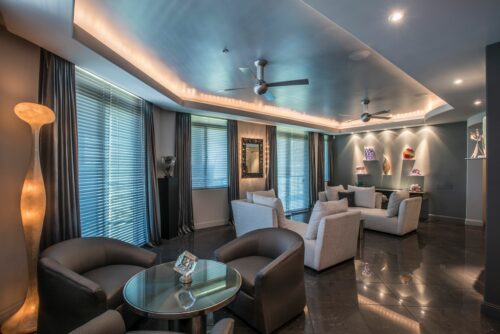 “What to do about lighting?” is the question every client asks me. They want to know: “Do I buy lamps, install track lighting, have recessed cans put in the ceiling, use up-lights, indirect lights or cable lights? What’s the difference between halogen bulbs and incandescent bulbs and now LED?
“What to do about lighting?” is the question every client asks me. They want to know: “Do I buy lamps, install track lighting, have recessed cans put in the ceiling, use up-lights, indirect lights or cable lights? What’s the difference between halogen bulbs and incandescent bulbs and now LED?
Lighting, magically, makes everything in a room come alive, so it’s important to place lights strategically. Proper lighting makes the difference! Because all color is affected by light, the kind of lighting, will make a huge difference in the feel of your rooms. Lighting affects mood and brings style and personality to any environment. You can have tranquility or excitement with a flick of a switch.
There is no one answer. Decide on the effect you want to create in your home. Builders understand the importance of lighting and often provide recessed canned lights, flush with the ceiling; however, they don’t provide very many. Add more cans in strategic areas where lighting is beneficial and to create the effect you want to achieve.
Bulbs: LED is replacing incandescent and halogen. Incandescent bulbs give off a yellow light. Halogen bulbs throw off a white light. The new LED lighting now comes in a variety of colors and resemble traditional bulbs. They have to be chosen carefully for the affect you want to achieve. Lumens is a measurement of the light output. The color temperature of the light source is measured in Kelvins. White light doesn’t change the true color of fabrics, wall coverings and flooring. Yellow light adds warmth. It is very important to question the differences based on your preference. Lenses can also be changed to control the spread of the light.
LED is now widely used for chandeliers and pendant fixtures. The decorative covering will change the lighting color based on its design and color.
Switches: I’m a great believer in using as many as possible and practical – it’s a great way to save money in the long run. Particularly if you have installed several ceiling lights over different areas in the room. Switching lights individually gives versatility and is energy efficient. The more you separate the lights and give them their own switches, the greater the choice you have in putting light where it is needed or wanted.
Lighting can be glaring so you might want to include dimmer switches. They control the amount of light you want in a room and often add a wonderful mood.
Lamps: When choosing a lamp, consider design, size and proportion, as well as color and material. Shades come in many colors and with trims such as beads or glass. Ask yourself: Is the lamp making a fashion statement or is it an art object? Of course, whatever you choose has to accent the style of the room.
Up-lights: Up-lights on timers can be used to highlight plants and artwork. The drama of up-lights is also a surprise feature. Because people don’t customarily expect lighting on the floor, it adds a new dimension to the room. It also creates designs on your ceiling. I have up-lights on timers in every room of my home so I always have subtle illumination until bedtime.
Create lighting for your lifestyle and to highlight the beauty in your home.
Remember, rooms have no feelings, YOU do! So light up your life!
